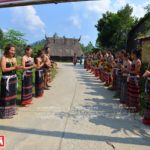By 2024, Vietnam’s tourism industry aims to attract 17-18 million international visitors and around 110 million domestic tourists, representing a 30% and 2% increase, respectively.
| Foreign travelers in Hanoi. Photo: Hanoi Tourism Department |
To achieve this goal, Chairman of the Vietnam National Administration of Tourism (VNAT) Nguyen Trung Khanh has proposed seven breakthrough solutions at a recent tourism conference titled “Solutions for the Tourism Sector to Achieve Breakthroughs” held in Ho Chi Minh City.
These solutions include completing the Tourism Master Plan for the 2025-2030 period, with a vision for 2045. Once the plan is approved by the Prime Minister, the tourism industry will set the direction for implementation. The sector will promote connectivity, develop green and sustainable destinations, and prioritize enhancing the tourist experience.
| A foreign traveler in Hoi An Ancient Town, Quang Nam Province, Vietnam. Photo: Nguoi Hoi An Group |
Khanh stated that the sector will propose content and innovative commercial promotion methods based on various segments, including community-based tourism, wellness tourism, rural tourism, MICE tourism, golf tourism, and railway tourism. Moreover, Vietnam will establish trade and tourism promotion offices abroad, with Vientiane (Laos) being the first planned location.
Additionally, it is essential to develop tourism products that capitalize on strengths and advantages to attract both domestic and foreign tourists and, importantly, retain them with suitable offerings.
“It is necessary to research and propose solutions to overcome obstacles facing localities and tourism businesses, especially issues related to investment and taxation,” stated Khanh.
Furthermore, collaboration with local authorities is needed to manage destinations and ensure the safety of tourists. The sector should also focus on digital transformation and the development of tourism databases.
According to VNAT statistics, Vietnam welcomed 12.6 million international tourists in 2023, surpassing the annual target of around eight million. The country also recorded approximately 108 million domestic arrivals.
Speaking at the conference, Le Truong Hien Hoa, Deputy Director of the Ho Chi Minh City Department of Tourism, emphasized that HCMC played a leading role in Vietnam’s tourism sector in 2023, both in terms of arrivals and tourism revenue.
Last year, Ho Chi Minh City welcomed nearly five million international visitors and catered to 35 million domestic travelers, generating a revenue of over VND160 trillion ($6.5 billion). The city has set a target of welcoming six million international visitors and earning VND190 trillion (US$7.8 billion) in tourism revenue this year.
| A girl crosses the vibrant Bui Vien Walking Street in Ho Chi Minh City, Vietnam. Photo: Mekong Smile |
“To develop the tourism sector, Ho Chi Minh City also focuses on human resource development and the creation of new, distinctive tourism products. Specifically, each district has developed a unique product to attract tourists. The city’s tourism sector has also organized various tourism and promotional events…”, he added.
Currently, Vietnam’s promotion of its tourism abroad has been effective, especially with the implementation of the new visa policy. The department had been utilizing media platforms and actively promoting destinations even prior to the policy’s introduction, resulting in commendable achievements, according to VNAT representatives.
When it comes to Hanoi’s tourism industry, Nguyen Hong Minh, Deputy Director of the Hanoi Tourism Department, mentioned that the department has formulated a tourism development plan for 2024, outlining special tasks and solutions. The department has also consulted with the city government to issue a separate conclusion on the city’s tourism development in the new situation in 2024-2025.
In terms of breakthrough policies for comprehensive tourism development in the capital in the coming period, the department has actively researched, advised, and submitted specific mechanisms and policies supporting the development of tourist destinations, as well as models of community-based, agricultural, and rural tourism in the capital to the Hanoi People’s Council.
“We are also collaborating with organizations and experts locally and internationally to conduct surveys and collect data to improve the statistical indicators and database system for the capital’s tourism industry. This will enable us to design strategies for developing tourism products that meet the evolving needs of tourists,” explained Nguyen Hong Minh.
Regarding new product development, Hanoi’s tourism sector will prioritize offering unique and appealing products to different tourist groups. Additionally, a comprehensive and professional program will be developed to promote the city through strategic international media and TV channels such as CNN, CNBC, or TikTok.
| Dreamy Hanoi in the fog. Photo: Nguyen Duc Long |
Pham Quy Huy, CEO of Kiwi Travel, noted that due to the relatively high price of domestic air tickets, Vietnamese travelers often opt to travel abroad rather than domestically. While Vietnam seeks to attract international visitors, this trend among domestic tourists poses a major obstacle to establishing long-term inbound tours.
To enhance the traveler experience, he recommended that the tourism sector not only attract visitors but also synchronize the peak travel seasons for each region, such as the central coastline or the northwestern mountains. Tourism businesses should also explore more effective collaboration methods to promote domestic travel and attract foreign tourists.
Developing tourism in the Mekong River Delta region
NDO – The Prime Minister has approved the overall planning and a master plan for developing tourism in the Mekong River Delta region until 2020 with a vision extending to 2030.












